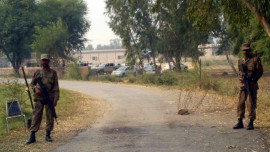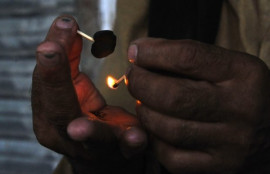
The role of Hamid Gul
‘Make the snow warm in Kabul’
The information contained in the WikiLeaks reports is, if true, damning. An entry from December 30, 2006 describes an alleged meeting between Gul and three senior, unnamed Taliban members that took place in Nowshera on December 17. In it, Gul is quoted as saying he had dispatched three men to use Improvised Explosive Devices (IEDs) to attack International Security Assistant Force (Isaf) in Kabul during Eid celebrations. Gul is also alleged to have provided the IEDs, which are described as being Chinese-made.
The report says: “Gul instructed two of the individuals to plant IEDs along the roads frequently utilised by Government of Afghanistan (GOA) and Isaf vehicles. The third individual is to carry out a suicide attack utilising a suicide vest against GOA or Isaf entities. Reportedly Gul’s final comment to the three individuals was ‘make the snow warm in Kabul’, basically telling them to set Kabul aflame.”
Eid-ul-Azha fell on December 31 that year. According to reports released by WikiLeaks, there were a number of attempted IED attacks before and after Eid. On December 30, “TF (task force) Iron Grays reported 8x IEDs were linked together approximately four kilometres northeast of FOB (Forward Operating Base) Methar Lam [...] TF Iron Grays reported a total of 8x Ammonium Nitrate IEDs had been removed (buried approximately 1 foot in the ground on the side of the road, with approximately 30 lbs of ammonium nitrate per plastic container) wired together as a command detonated IED”.
A report filed on December 31 cites that a patrol struck an IED and one vehicle was damaged, but no casualties were recorded.
Nowshera, while a hideout for the Swat leadership of the Taliban, has never been known as a hub of the Afghan Taliban. The only Afghan Taliban leader confirmed to have set up base in Nowshera was Mullah Kabir who was the governor of Nangahar province when the Taliban ruled Afghanistan and was arrested in the city this February. However the Chinese, at least officially, do not export landmines.
Prison break?
Hamid Gul is also implicated in a kidnapping plot. A report filed on January 14, 2008 says that the former ISI chief worked with Qari Naqibullah to kidnap United Nations (UN) officials in Jalalabad and use the hostages to trade for the release of three Pakistan army soldiers, posing as doctors, and six other detainees being held in the Pul-e-Charkhi prison in Afghanistan.
While Qari Naqibullah is believed to have had possession of IEDs, there is no record of this plan being carried out. Guantanamo Bay detainee Said Amir Jan, who lived next to Naqibullah, confessed in his hearing to have a stock of IEDs and that we was planning attacks in Jalalabad.
According to intelligence provided by the National Directorate of Security (NDS) on January 29, 2008: “Taliban Mullah Habibullah plans to attack the Pul-e-Charkhi jail to free three Anti-Coalition Forces (ACF) Pakistani prisoners.”
The only known kidnapping of UN officials in Afghanistan was in 2004, when three UN staff were kidnapped and then released. Additionally, there is a curious factual error in the report where it describes Gul as a “retired Pakistani ISI general currently serving with the Lashkar-e-Taiba faction of the PAKMIL (Pakistan military)”. Gul, whatever rhetorical support he may have given them, never actually served with the Lashkar-e-Taiba. And the Lashkar-e-Taiba, whatever support it may have received from the military, is certainly not a faction of the military.
Revenge
A report from January 2009 refers to a meeting in Wana between Gul, Taliban commanders and a group of Arabs in which it was decided to avenge the killing of a person, presumably an Afghan Taliban or al Qaeda member, by the name of Zamarai, by carrying out IED attacks in Sarobi district.
While the name ‘Zamarai’ is unknown, it is possible that they were referring to Usama al Kini, the head of al Qaeda operations in Pakistan, who was killed in an air strike on an unconfirmed date in January earlier this year. Al Kini is the only Afghan Taliban or al Qaeda member who was killed in the two months leading up to that alleged meeting.
However, the vivid details of the reports and plots paint a curious picture. In the January meeting, Gul allegedly “encouraged the AAF (anti Afghan forces) leaders to focus their operation inside of Afghanistan in exchange for the government of Pakistan’s security forces turning a blind eye to the presence of AAF commanders and fighters in Pakistan. Additionally, the AAF leaders approved a plan to send 50 Arab and 50 Waziri fighters to Ghazni province, Afghanistan in early February 2009. According to Hamid Gul, the aerial threats in the area were controlled from the airport in Wana.”
Deny, deny, deny
Gul has been vehement in his refutation of the information contained in the WikiLeaks reports. He told the Christian Science Monitor, “This is utter nonsense ... malicious, fictitious, and preposterous – and if this is the condition of US intelligence, then I am afraid it is no wonder they are losing in Afghanistan, and they will lose everywhere they try to poke their nose.” The ISI also denied that Gul had been freelancing for them. ISI spokesman Zafar Iqbal was quoted by The Wall Street Journal as saying, “He hasn’t worked for the ISI in any capacity since he left the organisation.”
Journalist Mohammed Hanif, when asked whether Gul was still actively involved or had become a mere talking head, says, “Many may not remember but he is the same dude who 20 years ago set out to conquer Jalalabad after the Soviets withdrew. On his way to Jalalabad he started taking these little media breaks to talk to journalists, to make TV appearances etc. That’s why he still hasn’t made it to Jalalabad but he has never quite called off his campaign. Some might say that his progress has been a bit slow but do you even know how many talk shows there are on Pakistani news channels?”
According to Hanif, “The last I heard was that he was in the transport business in Rawalpindi and doing quite well. I have also heard him on a TV show describing himself as a visionary. So I think he is probably a visionary transporter with a sideline in TV talk. How can even the ISI object to that?”
Suspicious
But even before the reports had been released, Hamid Gul was accused of aiding and abetting terrorism, although never with any proof.
In October 2006 then-President Pervez Musharraf said ex-ISI members may be helping the Taliban. He specifically mentioned those who were at the forefront of the agency from 1979-89, the period when the ISI was aiding the mujahideen to fight Soviet forces in Afghanistan. These remarks were considered to include Gul and, indeed, Gul himself felt the need to respond to Musharraf’s statement and deny that he was helping the Taliban.
In 2007, Benazir Bhutto wrote a letter to Musharraf and identified three people she considered a threat to her security, which included Hamid Gul.
After the Mumbai attacks of 2008, the US government appealed to the United Nations to place him on a list of international terrorists but the move was vetoed by China.
Yet the charges continue to surface, probably because of Gul’s repeated rhetorical support for the Taliban and Osama bin Laden. In an interview with Al-Jazeera he said of the Taliban, “I support their cause of Afghan resistance. I lend them my moral support because I have in the past had strong connections with them.” He was equally effusive of al Qaeda when he spoke to United Press International soon after 9/11: “I know Bin Laden and his associates. I’ve been with them here, in Europe and the Middle East. They are graduates of the best universities and are highly intelligent with impressive degrees and speak impeccable English.”
Published in The Express Tribune, August 5th, 2010.














































COMMENTS (55)
Comments are moderated and generally will be posted if they are on-topic and not abusive.
For more information, please see our Comments FAQ